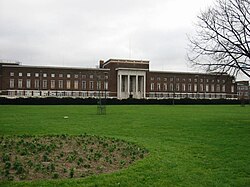Civic Centre, Dagenham
| Civic Centre | |
|
Essex | |
|---|---|
 The Civic Centre, Dagenham | |
| Location | |
| Grid reference: | TQ49568680 |
| Location: | 51°33’37"N, 0°9’22"E |
| Town: | Dagenham |
| History | |
| Built 1936-1937 | |
| By: | Ernest Berry Webber |
| Modern architecture | |
| Information | |
The Civic Centre in Dagenham is a former municipal building standing in Becontree Heath, an area of Dagenham in the urban corner of Essex. The building was designed in the modernist style by the British architect Ernest Berry Webber in 1936 and was opened the following year. The local authority (in each succeeding incarnation) occupied the building until 2016 when it was vacated and leased to CU London, a new university, the following year.
The Civic Centre is a Grade II listed building.[1]
History
Becontree, where the Civic Centre stands, was created as a new neighbourhood, between 1921 and 1935; not by developers nor the local council but by the London County Council, to alleviate the lack of land in its own area. A cottage estate, comprising around 26,000 homes, was developed. The area was to be called 'Becontree'.[2]
In August 1928 the government acquired 135 acres to create a public space, and planners decided to designate the entrance to the area, since named Central Park, as the site of a new municipal building which was intended to be the work premises for members of the local authority.[3]
Construction of the Civic Centre, which was undertaken by Allen Fairhead and Sons Limited,[4] began in 1936 and was completed in October the following year. It was designed by Ernest Berry Webber, a designer of municipal buildings, who the same year designed Hammersmith Town Hall.[5] He originally intended the building to be part of a complex which was to also include a fire station, library, shops, assembly hall and theatre, but the plan never came to fruition. The land on which the building was constructed featured lily ponds which became known as "blue lagoons" by the locals. The ponds were illuminated and filled with goldfish. The fish gradually died out, and in 1953 the ponds were filled in.[6]
The Civic Centre's foundation stone was laid by Harry Snell, 1st Baron Snell on 11 July 1936.[7] The building was officially opened on 16 October the following year by Sir Kingsley Wood[8] who was the Secretary of State for Health.[6]
Design
The Civic Centre is designed in the modern style.[5] The interior features a stair hall which is made using champagne-coloured Botticino marble and the ceilings are decorated with art deco paintings. The internal doors are mostly mahogany with bronze fixtures. The Council Chamber is semi-circular in layout and is flanked by walnut-panels. The Mayor’s Parlour is panelled in Canadian betula veneer and sycamore. The building has a number of pieces of specially designed walnut furniture.[6]
Later history
In 1964 the local authority deemed the Civic Centre too small to house the 500 staff that they employed so built extensions to the south.[6] It was designated as a Grade II listed building in 1981.[9]
In 2003, the building underwent a major refurbishment. The work was carried out by the architectural practice Richard Griffiths & Hawkins Brown who removed all non-original fittings and restored the original stonework. The ceiling was stripped to reveal the original paint colours. The main Council Chamber was fitted with audio-visual equipment, air conditioning, a scene-setting lighting scheme, induction loops and more flexible furniture to allow different seating plans. Also upgraded and remodelled were the meeting rooms, members lounge, washrooms, kitchen and offices. Lifts were installed in the main foyer.[6]
In March 2014, the building was threatened with closure to save money but a local petition forced the council to defer their decision pending further information and in December 2015, the council scrapped the proposed sale. A plan was proposed to turn the Civic Centre into a school, but in September 2017, CU London, part of the Coventry University Group, launched a new university in the Civic Centre, with permission from the council.[10] A £4.5 million contract was awarded[11] to modernise the building for higher educational purposes.[12]
Outside links
| ("Wikimedia Commons" has material about Civic Centre, Dagenham) |
References
- ↑ National Heritage List 1064422: Dagenham Civic Centre (Grade II listing)
- ↑ "Homes For Heroes", Locallocalhistory.co.uk, accessed 2 September 2020.
- ↑ "Dagenham's Civic Centre", The Essex Chronicle, 22 October 1937, p. 4.
- ↑ 'London's Town Halls' (Historic England)
- ↑ 5.0 5.1 National Heritage List 1079785: Hammersmith Town Hall
- ↑ 6.0 6.1 6.2 6.3 6.4 "Dagenham Civic Centre": Local Studies Information Sheet No.48
- ↑ "Dagenham Civic Centre 1935", Pathé News, accessed 27 February 2016.
- ↑ "Tribute to Local Government", The Nottingham Evening Post, 16 October 1937, p. 5.
- ↑ National Heritage List 1064422: Main Building and Council Chamber of Dagenham Civic Centre (Grade II listing)
- ↑ Rasiah, Janine. "Coventry University holds open day at Dagenham Civic Centre campus" (in en). Barking and Dagenham Post. http://www.barkinganddagenhampost.co.uk/news/education/coventry_university_holds_open_day_at_dagenham_civic_centre_campus_1_4744806.
- ↑ Ltd, Insider Media. "Willmott Dixon wins £4.5m Coventry University contract" (in en-GB). Insider Media Ltd. https://www.insidermedia.com/insider/national/willmott-dixon-wins-4.5m-coventry-university-contract.
- ↑ "Willmott Dixon wins Coventry Uni's London campus fit-out". http://www.theconstructionindex.co.uk/news/view/willmott-dixon-wins-coventry-unis-london-campus-fit-out.